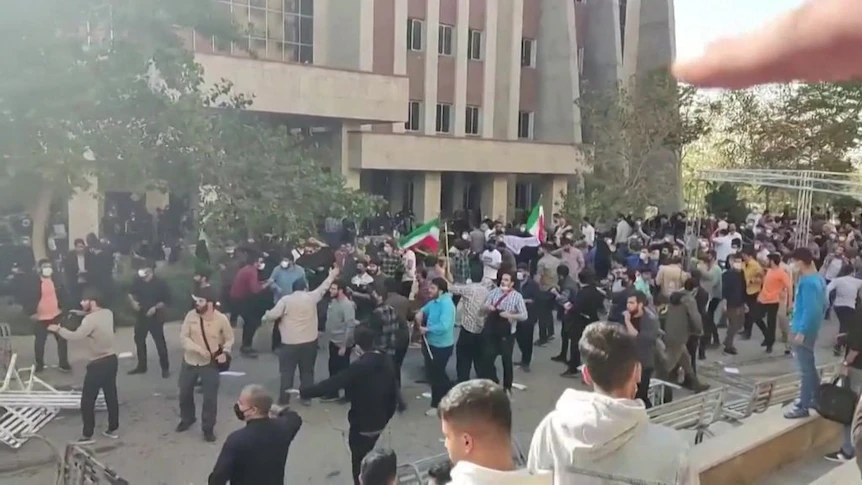Iran protests continue in defiance of government warnings as violence escalates
Videos on social media appear to show the demonstrations in Iran entering a more violent phase, with protesting students being met with tear gas and gunfire while defying an ultimatum by the Revolutionary Guards and a warning from the president.
Confrontations at dozens of universities prompted the threat of a tougher crackdown in the seventh week of demonstrations sparked by the death of 22-year-old Mahsa Amini after she was arrested by the morality police for attire deemed inappropriate.
“Security is the red line of the Islamic Republic, and we will not allow the enemy to implement in any way its plans to undermine this valuable national asset,” Iranian President Ebrahim Raisi said, according to state media.
Iranians from all walks of life have taken to the streets since Ms Amini’s death in demonstrations the clerical rulers have said are endangering the Islamic Republic’s security.
Authorities have accused the United States, Israel and their local agents of being behind the unrest and seeking to destabilise the country.
What began as outrage over Ms Amini’s death on September 16 has evolved into one of the toughest challenges to the country’s clerical rulers since the 1979 revolution, with some protesters calling for the death of Supreme Leader Ayatollah Ali Khamenei.
The top commander of Iran’s Revolutionary Guards told protesters that Saturday would be their last day of taking to the streets, the harshest warning yet by Iranian authorities.
People in London demonstrate in support of the Iranian protesters.
Nevertheless, videos on social media that could not be independently verified showed confrontations between students and riot police and Basij forces at universities all over Iran on Sunday.
One video showed a member of Basij forces firing a gun at close range at students protesting at a branch of Azad University in Tehran.
Gunshots were also heard in a video shared by rights group HENGAW from protests at the University of Kurdistan in Sanandaj.
Videos from universities in some other cities also showed Basij forces opening fire at students.
Across the country, security forces tried to block students inside university buildings, firing tear gas and beating protesters with sticks.
The students, who appeared to be unarmed, pushed back, with some chanting, “Dishonoured Basij get lost,” and “Death to Khamenei”.
‘So far, Basijis have shown restraint,’ government warns
At least a dozen doctors, journalists and artists have been arrested since Saturday, according to social media reports.
The activist HRANA news agency said 283 protesters, including 44 children, had been killed in the unrest as of Saturday. Some 34 members of the security forces were also reportedly killed.
More than 14,000 people have been arrested, including 253 students, in protests in 132 cities and towns, and 122 universities, HRANA said.
The Revolutionary Guards and its affiliated Basij force have crushed dissent in the past.
They said on Sunday that “seditionists” were insulting them at universities and in the streets, and warned they might use more force if the anti-government unrest continued.
“So far, Basijis have shown restraint and they have been patient,” the head of the Revolutionary Guards in the Khorasan Junubi province, Brigadier General Mohammadreza Mahdavi, was quoted as saying by state news agency IRNA.
“But it will get out of our control if the situation continues.”
Activists said 283 protesters had been killed in the unrest as of Saturday.
Appeal to release journalists
In a statement published by the Iranian Etemad and other newspapers on Sunday, more than 300 Iranian journalists demanded the release of two colleagues who were jailed for their coverage of Ms Amini’s arrest and death.
Niloofar Hamedi took a photo of Ms Amini’s parents hugging each other in a Tehran hospital where their daughter was lying in a coma.
The image, which Ms Hamedi posted on Twitter, was the first signal to the world that all was not well with Ms Amini, who had been detained three days earlier by Iran’s morality police for what they deemed inappropriate dress.
Elaheh Mohammadi covered Ms Amini’s funeral in her Kurdish hometown Saqez, where the protests began.
A joint statement released by Iran’s intelligence ministry and the intelligence organisation of the Revolutionary Guards on Friday accused Ms Hamedi and Ms Mohammadi of being CIA foreign agents.
Students and women have played a prominent role in the unrest across Iran, burning their veils as crowds have called for the fall of the country’s leadership, which came to power in 1979.
An official said on Sunday the establishment had no plan to retreat from compulsory veiling but should be “wise” about enforcement.
“However, our actions should be wise to avoid giving enemies a pretext to use it against us.”
In a further apparent effort to defuse the situation, Parliament Speaker Mohammad Baqer Qalibaf said people were right to call for reform and their demands would be met if they distanced themselves from the “criminals” taking to the streets.
“We consider the protests to be not only correct and the cause of progress, but we also believe that these social movements will change policies and decisions, provided that they are separated from violent people, criminals and separatists,” he said, using terms officials typically use for the protesters.









